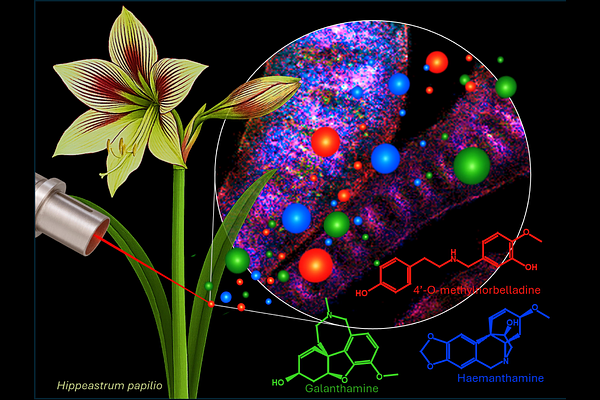Dissecting specialized metabolism in space: A MALDI-MSI atlas of Amaryllidaceae alkaloids in Hippeastrum papilio (Ravenna) Van Scheepen

Dissecting specialized metabolism in space: A MALDI-MSI atlas of Amaryllidaceae alkaloids in Hippeastrum papilio (Ravenna) Van Scheepen
Liyanage, N. S.; Merindol, N.; Pedersen, K. M.; Janfelt, C.; Desgagne-Penix, I.
AbstractAmaryllidoideae produce specific specialized metabolites known as Amaryllidaceae alkaloids (AAs), extensively studied for their significant pharmacological potential. AAs' spatial distribution and biosynthesis within plant tissues remain poorly understood. This study investigates organ- and tissue-specific localization in Hippeastrum papilio, from precursors to galanthamine and haemanthamine, using matrix-assisted laser desorption/ionization mass spectrometry imaging. Consistent accumulation of AAs was observed in epidermal and vascular tissues, with leaves exhibiting a uniform distribution across all ages and positions. Bulbs exhibited higher concentrations in the outer-scales and basal-plates, while roots displayed compartmentalized patterns, with galanthamine being uniquely abundant in the vascular bundles. Haemanthamine and galanthamine were detected in high quantities in the leaves' and bulbs' mucilage, while precursors were scarce. Multivariate analyses revealed that precursors clustered separately from end-products and were specifically enriched in the middle-scales and apical-leaves of the bulbs. Nonetheless, biosynthetic intermediates were observed in all tissues, indicating widespread AA biosynthesis across all organs. These findings suggest a coordinated metabolic network in H. papilio, which challenges existing hypotheses on organ-specific AA biosynthesis and hints at the transport of end-products. This study refines current models of alkaloid biosynthesis and underscore the value of H. papilio as a promising resource for sustainable production of therapeutic AAs.